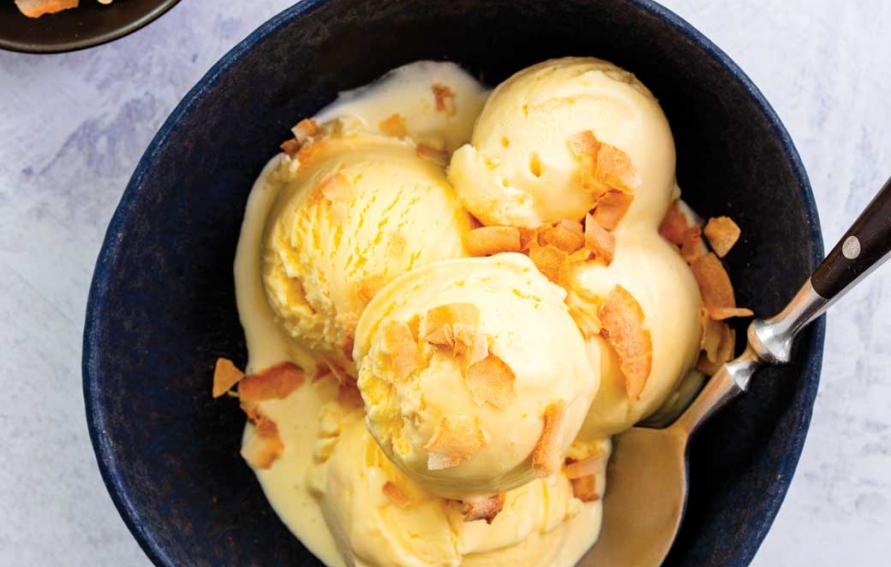Ingredients
- 1½ cups milk (355 ml/363 grams)
- 3 tablespoons nonfat dry milk (21 grams)
- 1¼ cups unsweetened shredded coconut (100 grams)
- ½ cup (118 ml/288 grams) cream of coconut, well stirred
- 6 (to 9) large egg yolks (¼ cup plus 3 tablespoons (104 ml)
- 2 tablespoons (30 ml/42 grams) glucose or reduced corn syrup (see recipe for more)
- Pinch fine sea salt
- 1½ cups (355 ml/348 grams) heavy cream
- ¼ teaspoon (1.2 ml) pure vanilla extract
- 1 cup sweetened flaked coconut (84 grams)
About this recipe
Excerpted from Rose's Ice Cream Bliss © 2020 by Rose Levy Beranbaum. Photography © 2020 by Matthew Septimus. Reproduced by permission of Houghton Mifflin Harcourt. All rights reserved.
Makes about 1 generous quart/1 generous liter
I came really close to giving up on this ice cream because the flavor was too subtle. Then I remembered that cream of coconut, produced from the pulp of the coconut, has a much deeper coconut flavor than coconut milk because it has much less added water. It also has quite a bit of sugar and coconut oil, so I used unsweetened coconut to steep in the milk, and added more milk in proportion to cream to lower the fat content. The lovely creamy consistency is in good part due to the guar gum contained in the cream of coconut. Only a whisper of vanilla is needed to heighten the flavor without overpowering it. An optional sprinkle of toasted coconut adds a delightful crunch.
Instructions
In a medium saucepan, with a silicone spatula, stir together the milk and dry milk. Bring it to a boil, stirring constantly, and simmer for 2 minutes. Remove it from the heat and add the shredded coconut. Cover and let it steep at room temperature for 1 to 1½ hours.
Scrape the cream of coconut into a medium saucepan. With a silicone spatula, stir in the egg yolks. Then stir in the glucose and salt. Set a fine-mesh strainer over the pan and pour the shredded coconut and milk mixture into it. Squeeze all the liquid from the coconut and discard the coconut. Set the strainer over a medium bowl. Stir the coconut mixture until well blended.
Heat the mixture on medium-low, stirring constantly, until slightly thicker than heavy cream. When a finger is run across the back of the spatula, it will leave a well-defined track. An instant-read thermometer should read 170° to 180°F/77° to 82°C.
Immediately pour the mixture into the strainer, scraping up the thickened mixture that has settled on the bottom of the pan. Press it through the strainer and scrape any mixture clinging to the underside into the bowl.
Stir in the heavy cream and vanilla. Cover and refrigerate for a minimum of 8 hours or until no warmer than 43°F/6°C. (Alternatively, cool in an ice water bath.) Set a covered storage container in the freezer.
Churn the coconut custard in a pre-chilled ice cream maker. Transfer the ice cream to the chilled container. Press a piece of plastic wrap on the surface of the ice cream, cover the container, and allow the ice cream to firm in the freezer for at least 4 hours before serving.
STORE: Covered storage container: frozen, 3 days
Glucose and Corn Syrup
Glucose, an invert sugar (formed through hydrolysis, or breakdown of sucrose), is an indispensable ingredient for minimizing ice crystals and keeping ice cream “scoopable,” because it bonds more with water than does granulated sugar (sucrose), so less water is available to freeze into ice. Corn syrup can be substituted for glucose, but it is best to thicken it to the moisture level of glucose – easily done. If you just use it straight, it will not be as effective as glucose.
Years ago, when glucose was harder to find, I worked out the following substitution for liquid glucose for making rolled fondant in The Cake Bible. Glucose is now widely available in candy making and cake baking supply stories and online. But if you don’t have any on hand, it is handy to have this technique.
To replace glucose with corn syrup, in a glass measure with a spout in a microwave, or in a small, preferably nonstick pan on the cooktop over medium-low heat, bring 80 grams/1/4 cup/59 ml of light corn syrup to a full boil. Remove it from the heat source and stir in an equal weight or volume of corn syrup. This will result in the same consistency of glucose. Corn syrup weighs only 1 gram less per tablespoon than glucose, so it can be used in equal weight or measure but will not be quite as effective in preventing iciness.
I usually use 4.5% glucose in my recipes, or 5% if an ice cream freezes very hard; no more than 5% should be used.
Toasted Coconut Topping
Spread the coconut in a thin layer on a baking sheet. In a preheated 350°F/175°C oven, toast the coconut for 7 to 10 minutes, stirring often, until lightly browned.
STORE: Airtight: room temperature, 3 weeks



